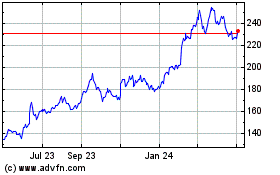Car Safety: Toyota's Enduring Pain - Analyst Blog
December 28 2012 - 5:30AM
Zacks
The vehicle safety and recall fiasco continue to whip
Toyota Motor Corp. (TM). This time, the company
would end up paying $1.1 billion to settle a class-action lawsuit
related to complaints of unintended acceleration in its vehicles.
According to a plaintiff lawyer, the settlement is one of the
largest in a lawsuit in the history of automotive industry.
The lawsuit blamed Toyota’s defective electronic throttle-control
system rather than floor mats and sticky accelerator pedals for
unintended acceleration, resulting in a crash. The settlement would
pacify 16 million owners of Toyota, Lexus and Scion of model years
1998 to 2010. They would be eligible for payments and safety
updates on their vehicles.
Key Provisions of the Settlement
Some of the key provisions of the proposed settlement (which are
yet to be approved by a federal judge) are –
• Toyota will establish a fund of $250 million in
order to compensate some owners for getting lower resale value of
their vehicles stemming from publicity related to unintended
acceleration. Those owners sold their cars between September 1,
2009 and December 31, 2010.
• Toyota will be required to install a
brake-override system in roughly 3.25 million vehicles, which were
subject to floor mat recalls.
• Toyota should also establish a fund of $250
million to compensate existing owners whose vehicles are not
eligible for a brake-override system. The amount of individual
compensation would depend on the model, model year, and the state
where the car was purchased.
• Toyota would make all 16 million-vehicle owners
eligible for a customer care plan for 3–10 years that will warranty
certain parts that are tied to unintended acceleration.
• Toyota would provide $30 million in education
grants to independent academic institutions to undertake vehicle
safety-related studies and improve driver education.
Any More Lawsuits?
Although Toyota still faces hundreds of personal injury lawsuits
related to unintended acceleration, the company believes the latest
settlement would be the biggest nail in the coffin.
According to a company filing in June, Toyota faces more than 300
wrongful death or injury lawsuits. However, plaintiffs in those
smaller cases might face difficulty in claiming damages, as it will
become harder to prove.
U.S. Government Fine
Recently, the Transportation Department of U.S. slapped a fine of
$17.35 million on Toyota due to late response regarding a defect in
its vehicles to safety regulators as well as late recall of those
vehicles. According to the department, it was the maximum allowable
fine under the law for not initiating a recall in a timely
manner.
In May this year, National Highway Traffic Safety Administration
(NHTSA) notified Toyota about “floor mat pedal entrapments” in some
of its Lexus hybrid models. Manufacturers are legally obligated to
notify the U.S. safety regulators within five business days once
they come to know of a safety defect.
However, the automaker responded a month later stating that it is
aware of 63 incidents related to the defect in the vehicles.
Consequently, it announced a recall of 154,036 units of Lexus RX
350 and RX 450h luxury hybrid sports utility vehicles in June in
order to fix the problem of loose floor mat that could force down
the accelerator pedal.
The latest fine adds to $48.4 million imposed by the U.S.
government on the company in 2010 due to late recall of millions of
defective vehicles.
The Downfall
Since November 2009, the automaker has recalled about 20 million
vehicles globally, surpassing all other automakers. The company
also lost its No.1 position to General Motors
Company (GM) and Ford Motor Co. (F) in
terms of sales volumes in the U.S. due to the loss of reputation as
well as negative impact from natural disasters in Japan and
Thailand in 2011.
A couple of months back, Toyota announced a major worldwide recall
of 7.43 million vehicles that included more than a dozen models
manufactured between 2005 and 2010. The recall was related to
faulty power window switches in the vehicles that can cause fire
because they did not have grease applied properly during
production.
Impressive Earnings but Lower Outlook
Toyota, a Zacks #4 Rank (Sell) stock, saw more than threefold
increase in profits to ¥257.92 billion ($3.28 billion) or ¥81.44
($1.04) per share in the second quarter of fiscal year ended
September 30, 2012 from ¥80.42 billion or ¥25.65 in the same
quarter of prior fiscal year.
The increase in profits can be attributable to strong demand for
Toyota vehicles as well as positive impact from the company’s cost
control measures. However, profits were lower than the Zacks
Consensus Estimate of $1.62 per share.
Revenues in the quarter grew 18.2% to ¥5.41 trillion ($68.75
billion) on a 14.9% rise in sales volume to 2.16 million units.
Vehicle sales increased in all the regions, except Europe.
Operating income more then quadrupled to ¥340.61 billion ($4.33
billion) from ¥75.39 billion in the second quarter of previous
fiscal year.
However, Toyota projected lower consolidated vehicles sales of 8.75
million units for fiscal 2013 ending March 31, 2013, down 50
thousand units from the prior guidance. The automaker also lowered
its consolidated revenues outlook to ¥21.30 trillion (up 14.6% from
fiscal 2012) from the prior guidance of ¥22.00 trillion. The
downward revision of sales outlook was based on difficulties in
Chinese and European markets.
FORD MOTOR CO (F): Free Stock Analysis Report
GENERAL MOTORS (GM): Free Stock Analysis Report
TOYOTA MOTOR CP (TM): Free Stock Analysis Report
To read this article on Zacks.com click here.
Zacks Investment Research
Toyota Motor (NYSE:TM)
Historical Stock Chart
From Jun 2024 to Jul 2024

Toyota Motor (NYSE:TM)
Historical Stock Chart
From Jul 2023 to Jul 2024
